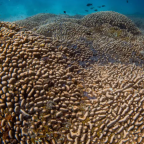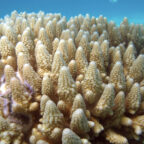
The color coral gets its unique coloration from the organisms that live within the coral, forming a symbiotic relationship with it. The organisms that give coral their color are called zooxanthellae, and the coral reefs provide the organisms with a safe place to live.
To better understand the relationship between coral and zooxanthellae, it would help to know some more about both the coral and the zooxanthellae that inhabit the coral.
Fact about coral
Coral, though many people mistake them for plants, are actually marine invertebrates. Coral are of the class Anthozoa of phylum Cnidaria, and they can reproduce either sexually or asexually. The Cnidaria phylum contains other creatures like anemones and jellyfish, any animal which can be referred to as a polyp.
Coral typically coexist in tight groups or colonies made out of polyps. The polyps are often genetically identical individuals, and they are typically quite small, only a few centimeters in length. The polyps have a mouth capable of taking in food, which is surrounded by tentacles. Coral polyps grow upon the skeletons of their predecessors, and over time this process can create large coral reefs.
Coral is found all around the world, from the cold waters off the Alaskan coast to the much warmer tropical waters in the Caribbean sea. The largest coral reefs tend to be found within tropical waters, such as the Great Barrier Reef of Australia, which is longer than 2400 kilometers (1500 miles) in length.
As previously mentioned coral can reproduce either sexually or asexually, with the preferred method depending on the type of coral. Coral colonies can be either hermaphroditic in nature or diocious in nature in terms of sexual reproduction, while they are also capable of reproducing asexually through the process of fragmentation. The sexual reproduction of coral is accomplished by releasing their sex cells into the water over the period of several days. Beneath their soft outer body, coral secrete a substance known as calcium carbonate, which forms their skeleton. This calcium carbonate skeleton becomes the basis for coral reefs.
The Formation of Coral Reefs
All scleractinian corals have calcium carbonate skeletons, yet not all corals will grow large enough to form the basis for a coral reef. Reef-building corals are typically found in tropical waters and they are able to grow rather large thanks to the assistance of zooxanthellae. The zooxanthellae photosynthesize and exchange nutrients and food with the coral they host them. The added nutrition from the zooxanthellae means the coral can grow much larger and create many layers of calcium carbonate. Even with the added energy from zooxanthellae, it takes many years to form a coral reef, with branching species of coral only growing some 10 – 20 mm every year and large species of coral growing a scant 1 mm every year.
The formation of coral reefs is affected by a number of abiotic environmental factors such as both the salinity and temperature affect the rate of calcification. This means that tropical coral reefs between must exist in water between 23-29 degrees Celsius and exist in a salinity range of 32% to 40%. Reef-building corals also rely on zooxanthellae and their ability to photosynthesize, meaning that large coral reefs usually need to be in shallow depths where sunlight is plentiful, typically in water less than 25 meters in depth. The turbidity of water also reduces light penetration, so the water coral reefs exist in is typically fairly clear and relatively free of particles.
Most of the large coral reefs found in the world today are somewhere between 5,000 to 10,000 years old, and they are mainly in shallow, clear waters where the abundant sunlight helps the zooxanthellae photosynthesize. Despite the relatively large amount of area that coral reefs cover – a combined area of approximately 285,000 square kilometers (110,000 square miles) – they cover only around 1% of the entire ocean floor. Coral reefs support extremely diverse ecosystems, sometimes referred to as “underwater islands” by biologists, in reference to their tendency to support unique marine species found nowhere else in the ocean. In fact, it is thought that the “rainforests of the sea” form the primary habitats for not just 700 species of coral but also 4,000 different species of fish and thousands of more species of animals and plants.
Coral Reef Die-Off
Many marine species, and species which depend upon marine species, rely on coral reefs to live. In terms of the human relationship to coral reefs, coral reefs are thought to provide $30 billion dollars in direct economic benefit to people around the world through fisheries, food preparation and tourism. Despite all the benefits that coral reefs bring to many species, coral reefs around the world are under threat, withering and dying off due to a number of environmental strains.
One of the main reasons coral reefs are being damaged is due to the acidification of ocean water, which occurs due to the ocean absorbing an increased amount of carbon dioxide (released into the atmosphere by the combustion of fossil fuels). This acidification of the water causes the coral to be unable to produce calcium carbonate exoskeletons, weakening them substantially. Water pollution from sources like oil, fertilizers, pesticides and sewage discharge are also damaging the world’s coral reefs. The warming temperature of ocean waters also causes the coral reef to discharge their zooxanthellae, which reduces their ability to collect food and makes them lose their colors, a process known as coral bleaching.
Coral And Zooxanthellae
So what role do the zooxanthellae play in relation to the coral? Not only do these photosynthetic organisms assist the coral reef in the production of nutrients, the pigments within them that trap sunlight are also what give the coral their impressive array of colors. The pigments that the coral have are different colors depending on the coral’s needs. Some coral have certain colors that shield them against high levels of UV radiation, typically those that live close to the surface of the water. Hues like purple, pink and blue help protect the coral from harmful UV radiation.















Social Profiles